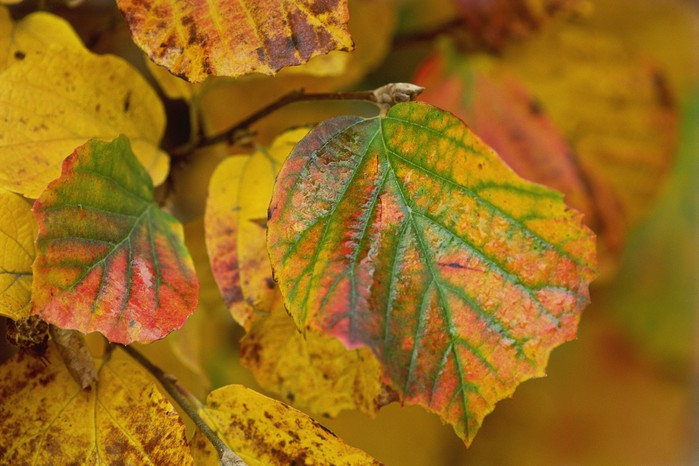
Autumn colour is all a result of our deciduous trees settling down into their winter routine and abandoning their leaves.
During spring and summer, the chloroplasts within the leaves combine sunlight, water and carbon dioxide to produce sugars to feed the plants and release oxygen. As temperatures fall and days shorten, the benefit from the leaves diminishes until it becomes a losing equation and the leaves are relinquished. Before this happens, the chlorophyll within the leaves, which has given them their green colour, is reabsorbed by the tree. The other colours within the leaves, which though present throughout the life of the leaf were disguised by the chlorophyll, can now be seen clearly.
Where and how you plan your autumn colour depends to a large extent on how big your garden is. But even if you can only fit in one spectacular acer that becomes the focal point, there are many herbaceous plants that adopt a different guise as day length shortens and that can play supporting roles in the autumn cavalcade. Among them is Gillenia trifoliata (renowned for its diaphanous white flowers earlier in the year) which has foliage that changes to orange and yellow, as do many others of the rose family, while the leaves of rodgersias turn ruby-red.
More plants for autumn colour:
Discover Carol Klein’s favourite plants for autumn colour, below.
Fothergilla major Monticola Group
Fothergilla major Monticola Group autumn leaves. Photo: Getty Images.
In spring, there are fluffy, spherical catkins, while in autumn, the round, hazel-like leaves of fothergilla change to a kaleidoscopic array of reds, oranges and ambers, often becoming pure yellow.
Height x spread: 1.5m x 1.5m (in 5-10 years).
Acer palmatum ‘Osakazuki’

Acer palmatum ‘Osakazuki’ autumn leaves. Photo: Getty Images.
‘Osakazuki’ has the best colour of all the Japanese acers, slowly turning from rich green to brilliant scarlet. Each day there is a quantitative change – a little more crimson being added until the crescendo is reached.
H x S: 4m x 4m (in 10-20 years).
Hydrangea quercifolia

Oak leaf hydrangea, Hydrangea quercifolia. Photo: Getty Images.
The oak-leaved hydrangea has trusses of creamy-white flowers in late summer and its large ‘oak’ leaves produce russets, reds and oranges in October, the epitome of autumn colour in just one shrub. It colours best in full sun.
H x S: 1.5m x 2.5m (in 5-10 years).
Cotinus ‘Grace’

Cotinus autumn colour. Photo: Getty Images.
Cotinus ‘Grace’ is an expansive version of the smoke bush, its large, round leaves are bronze-purple throughout summer, then become imbued with red in autumn. In some years it produces heads of ‘smoky’ flowers.
H x S: 8m x 4m (in 10-20 years).
Sorbus ‘Joseph Grace’

Sorbus ‘Joseph Rock’ autumn leaves. Photo: Jason Ingram.
One of the most outstanding of the mountain ash clan, it creates a sensational autumn display as its leaves begin to change to red, crimson and purple, a spectacle that is enhanced by its glorious pale-yellow fruits.
H x S: 12m x 8m (in 20-50 years).
Cercidiphyllum japonicum

Cercidiphyllum japonicum autumn colour. Photo: Getty Images.
The katsura tree is surely one of the most desirable of all trees. As its elegant rounded leaves turn almost imperceptibly to soft amber and pink, they simultaneously begin to emit the unexpected aroma of toffee apples.
H x S: 12m x 8m (in 20-50 years).
Viburnum opulus

Viburnum opulus autumn leaves and berries. Photo: Getty Images.
Our native guelder rose makes heads of exquisite white flowers in late spring, followed by almost translucent red berries. In its final glory, they are an accompaniment to deep-crimson leaves. A splendid shrub that thrives in clay soils.
H x S: 4m x 4m (in 10-20 years).
Cornus sanguinea

Cornus autumn/winter stem colour.
This dogwood has superb autumn colour, visible from far afield (or when you’re driving along motorways, especially in southern England). When leaves have fallen, its bright-red twigs go on making a valuable contribution.
H x S: 2.5m x 2.5m (in 5-10 years).
